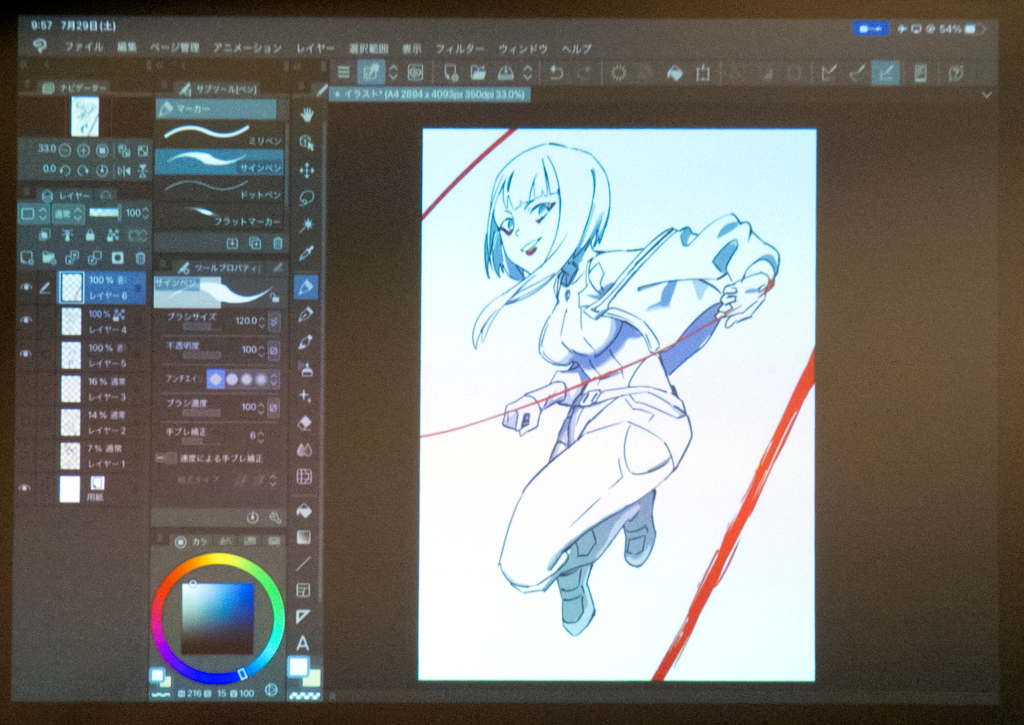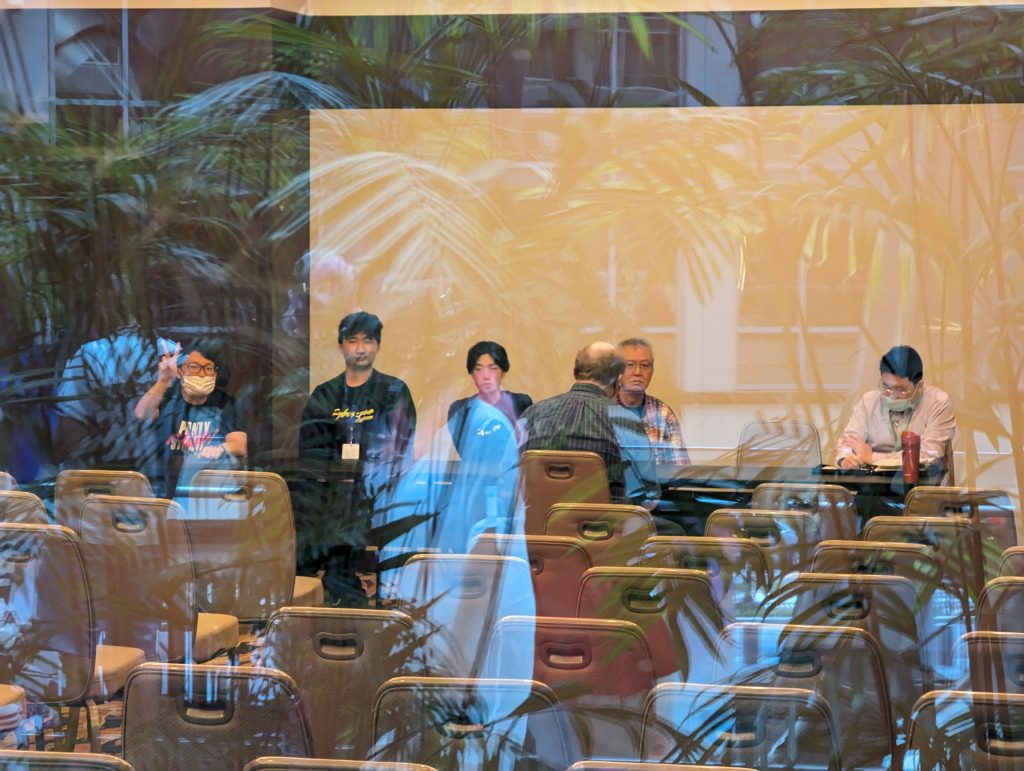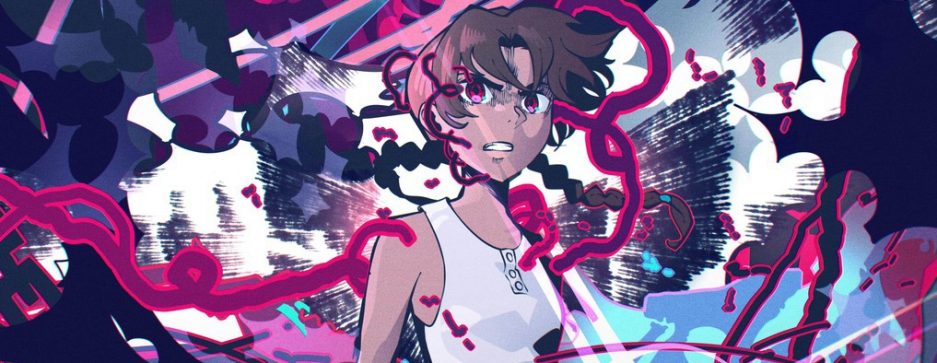
America 🤝 Trigger
They’ve been flying across the world to hang out at East Coast anime conventions for years – sometimes twice a summer. Absolute legends like Hiroyuki Imaishi, You Yoshinari, Sushio, Akira Amemiya, Megumi Kouno, and Shigeto Koyama have all previously been part of Trigger’s annual envoy – always with Tattsun tagging along as their interpreter.
Not this year.
For Otakon 2023, President Masahiko Otsuka decided to make the journey himself, and he brought along two skilled but essentially unknown young animators from the Fukuoka satellite: Shunpei Gunyasu and Tatsuya Saitou. Instead of Tattsun, the manager of their newly revived youtube channel, “Kawa-D,” was there to interpret and film. So what’s going on?
Let’s start with Trigger Fukuoka.
First of all, Trigger Fukuoka is Masahiko Otsuka’s baby. Otsuka spun it up in 2016, and since then Trigger has used it as a testbed for an all-digital production pipeline. He’s been developing the studio for years, and in fact spends more of his time there than at the main offices in Tokyo. They have “big plans.” Now with BNA, Cyberpunk: Edgerunners, and Dungeon Meshi, animators like Shunpei Gunyasu and Tatsuya Saitou who came up through Trigger Fukuoka’s system are beginning to take on increasing responsibility.
For that reason, I think that even with mainstream anime fans ecstatic for more Panty & Stocking with Garterbelt, and with Yoshihiro Miyajima’s directorial debut imminent, the developments at Trigger Fukuoka may actually be the most important for the studio’s trajectory through this decade and into the next. I’ll explain a bit more what I mean in a bit, but first, here’s how the three described the rationale for Trigger Fukuoka in their own words during their brief Saturday afternoon press conference:
Nate A.M.: Hi, I'm Nate Mollen with Artist Unknown. How are Trigger Fukuoka's digital pipeline experiments going? I'd like to hear the perspective of both Otsuka-san as president, and Saitou-san as someone who came up through the Fukuoka branch as a young animator.
Masahiko Otsuka: So with regards to animation in the digital age, traditionally the anime industry has been centered in Tokyo because that's what makes the most sense: it's close to everything and everyone else. Now in the digital age, your desk doesn't have to be next to the other guy because you're all connected digitally. So we believe that going digital gives us the ability to connect to people who want to come to Tokyo, but can't for various reasons.
It also lets us not put all our eggs in the same basket, because what if a natural disaster struck Tokyo? A huge amount of the animation industry would be wiped out, so I believe that having different locations would minimize the risk.
Another thing that we often think about is the idea of expanding our workflow to a worldwide scale – that we can connect people in Japan with people outside of the country. With everything in the animation process including the animation itself being done digitally, this ultimately should make sense, but we're seeing how that idea holds up in practice right now.
Takuya Saitou: So as one of the guinea pigs in this "Trigger Fukuoka digital pipeline experiment," I don't exactly have a bird's eye view on what's happening and how things are going now, but I can say that I do see more communication going between Tokyo and Fukuoka, and I guess in that sense the project has been a success from what I can see.
Otsuka: Gunyasu-kun is from Fukuoka too.
Shunpei Gunyasu: Yeah, when I heard that I don't have to go to Tokyo, and since my house is near Fukuoka, I was like "oh, I can stay in Fukuoka and still work? That's awesome!" So when they provided me with the choice to do that, that was a big yes from me, and I think that this is ultimately the right thing to do in terms of getting animators involved.
Is this a deep dive into the highs and lows of anime production in the digital age? No, but it’s interesting nonetheless. First though, Otsuka’s comments could very easily be taken out of context, so I’d like to clarify that the answer was in regards to studios, not freelancers. For those who haven’t been following along, there’s a huge volume of discourse in both English and Japanese about international freelancers: the coordination issues, the quality, the training, the broader industry context, etc., which I will absolutely not be addressing here.
As for what exactly Otsuka aims to accomplish, let’s see if we can unpack it. Spinning off support studios outside Tokyo is nothing new and does not require new workflows. Historically, the main reason is the one Otsuka didn’t mention: operational costs outside Tokyo are cheaper. Many such cheap manpower farms have been founded not just outside Tokyo but outside Japan entirely. Trigger Fukuoka is evidently not one of them. Moreover, Trigger already has partner studios with whom they can easily communicate: fellow Ultra Super Pictures members Liden Film and Sanzigen are conveniently co-located with Trigger in the same building. You can’t get much easier than that.
If the economic reasons have spawned cheap satellites and questionable outsourcing studios, in my experience, it’s those human reasons which Otsuka and Gunyasu highlighted that seem to motivate projects like Trigger Fukuoka. Otsuka grew up in the area too, and he told us all about its wonderful cuisine at their live drawing panel. Kenji Horikawa of PA Works painted me a similar vision for what a regional anime studio could be like when I ran into him at Otakon 2016, and of course, it continues to be a powerful force shaping Kyoto Animation’s development. Additionally, I should mention that Fukuoka is home to a campus of the Yoyogi Animation School, which may be another good reason to put a studio there.
Perhaps unsurprisingly, I suspect Otsuka’s ultimate goal is something like the relationship between Kyoto Animation and Animation Do before the arson derailed their plans: two tightly bound but more-or-less independent studios with a single public face that can operate mostly seamlessly thanks – in Fukuoka’s case – to their digital workflow. In fact, I wond how much of Otsuka’s “resiliency to natural disaster” argument is informed by KyoAni and Do’s experience. Furthermore, unlike the other USP studios, the main Trigger branch is free to shape, educate, and manage Fukuoka’s workload directly in a similar way to how AniDo is fed from the same training courses as KyoAni, and doesn’t have to weigh helping KyoAni against other responsibilities. That raises a question however, because despite the easy one-hour rail transit between the two studios, Animation Do nonetheless developed its own distinct culture. What’s the culture at Fukuoka like? Just who are Shunpei Gunyasu and Takuya Saitou?
Both of them had their key animation debut on BNA, and both of them worked on almost every episode – a workload they repeated for Cyberpunk: Edgerunners. Despite this, before Otakon, we had very few credited cuts for Gunyasu and absolutely none for Saitou. Gunyasu was perhaps best known for his walking animation in Edgerunners EP01 (for instance here and here), about which Chen Sheng-Meng had this analysis. He likens David and Lucy’s footsteps, which have the same timing but move on different frames, to counterpoint in music: a comparison which Gunyasu admits is a bit over his head. “Imitation” may actually be the more applicable musical concept here, but at any rate, these are excellent walk cycles. Besides the timing – evidently both corrected and inspired by You Yoshinari – Gunyasu’s draftsmanship in these cuts is superb.
We got a bit of a look at that during their live drawing and Q&A panels. Both of them decided to draw Lucy.


Gunyasu is left, Saitou is right. Gunyasu’s illustration has Lucy wearing David’s jacket after the events of the last episode. “If you know, you know.” Lucy is attacking with her monofilament wire in Saitou’s, which he sensibly titled Lucy in Action.
The live drawing panel started with Gunyasu and Saitou almost immediately confirming some more of their cuts. Gunyasu worked on the iconic Lunar date in EP02, but his favorite part was apparently working on the torture scenes in EP06. He didn’t specify which parts exactly – there are many such cuts – but in any case he greatly enjoyed it. “It’s not everyday you get to draw someone getting beaten up like that.” He was on again about the torture scene the next day, where he added that his “pencil just wouldn’t stop,” something which Kawa-D wasn’t totally sure how to put in English. This may strike some as morbid, but Gunyasu was good humored about it. “Maybe I just have too much stress from working with you guys,” he joked.
Outside of Edgerunners, Gunyasu also mentioned animating a scene in the last episode of Dynazenon where Yomogi jumps onto Dynazenon.
Tokusatsu action, torture scenes, and romantic encounters on the Moon aside, Gunyasu says that he prefers animating mundane scenes to action. With action, you can essentially “cheat,” but everyday scenes afford no such escape. In his eyes, action may as well be fantasy – a lie. He admits that this is somewhat unusual for Trigger, whose founding figures are after all beloved for their action and effects animation.
He may not be in such a minority at Trigger Fukuoka. Saitou also enjoys the challenge of animating mundane scenes, and even agrees that action is essentially built on lies – except that he rather enjoys lying. Perhaps like most animators, to say nothing of animators at Trigger, he likes the way action invites you to exaggerate movement – the timing and the extremes. You can see this different mindset in the scene where David first sees Lucy. He also apparently worked on one of the EP06 scenes where Lucy is deep diving in the ice bath – perhaps here.
Thanks to an ambiguously worded audience question, we also got the vanishingly rare inbetween confirmation. Apparently his first job was inbetweening a scene from SSSS.Gridman EP02 where Akane bumps into a teacher, drops her hotdog, and picks it up again. He says he quite enjoyed his time as an inbetweener. I doubt Saitou is such a case, but I often wonder how many animators have been pressured to “move on” to key animation due to financial and cultural pressures. It’s something I like to ask about when I can.
As for inspiration, Gunyasu says that getting corrections back from You Yoshinari is the highlight of his job. This echoes the sentiment of pretty much everyone to ever work with the man. Saitou didn’t talk about his inspirations at the studio, but now that we have some confirmations, I think it’s safe to say from his timing that he’s taken some notes from Yoshinari the Younger too.
This should go without saying since he was the one who took them overseas, but Otsuka seems to think very highly of the duo. An animator needs both solid draftsmanship and efficiency. The fact that both Gunyasu and Saitou were able to not only finish their line drawings but partly color them in an hour attests to their speed. It’s a skill that veterans like Toshiyuki Inoue sometimes complain has become devalued. Otsuka says that watching a good animator work like that is “precious.” Vtuber otaku will note that the word he used in Japanese was「尊い」– toutoi – or its colloquial form, “teetee.” Honestly? Same.
Gunyasu and Saitou’s efficiency probably has something to do with why they are consistently assigned so much damn work. The duo are in the middle of working on Dungeon Meshi along with many of the other young animators. In fact, Saitou had to finish one of his cuts just before his flight, or else he couldn’t come. As soon as they’re back in Japan, they’ll be back to work. In response to an audience question about how Edgerunner’s tragic story affected them, Gunyasu said that he’s drawing every waking moment not spent eating or sleeping, so he simply doesn’t have the time to think very hard about his feelings.
Good luck, Gunyasu.
Nonetheless, they’re quite excited about Dungeon Meshi and what it represents: a new director working with many new animators – animators informed by the legends of the main branch but whose dispositions don’t neatly fall into their existing cliques – animators who aim for creative responsibility themselves. Saitou says that while this time Otakon was hosting him merely as a part of Trigger, he hopes someday he can be invited back on his own terms as a distinguished veteran: lofty goals, but ones which Otsuka seems to believe in. I wish them the best of luck.

Ah, but since it’d be a shame for this information to be lost to time, here are some other notes I took about the two panels.
- The live drawing panel took place at 09:00 on Saturday, so they were both surprised and happy that enough people showed up to completely fill the room anyway.
- Gunyasu and Saitou both gave generic remarks regarding their work on Gridman Universe. Otsuka was impressed by the balance that director Akira Amemiya struck between the tokusatsu action and the precise, delicate personal drama between the teenagers.
- Otsuka assures us that some episodes of Dungeon Meshi are, in fact, already finished.
- Gunyasu characterizes DC as a city “making an effort to be pretty.” Saitou was excited to go on a pilgrimage to locations where The Winter Soldier was shot, and made Otsuka help reenact some scenes. I dunno anything about the MCU, but Evan Minto informs me that they were talking about the “on your left” scene. This, more than the respect for You Yoshinari, is how you know Trigger Fukuoka is really part of Trigger.
- Typical of Japanese guests, they were all impressed by the relative panache and openness of American anime fans, and the pervasiveness of cosplay at the convention compared to anime events in Saitou’s hometown. “It’s like Halloween.”
- Production for the new PS&G does not seem to have begun in earnest despite the new trailer apparently having a few new cuts.
- Otsuka pins the crazy number of key animators involved with modern anime to the increasing line count of character and prop designs. “Animation is evolving,” he says. This diagnosis is frankly simplistic at best, but after all, he was speaking off the cuff.
- Otsuka was apparently “crying as he typed” the scripts for Edgerunners.
- CD Projekt Red apparently wanted the ending of Edgerunners to be even more “drastic,” but staff held out for the warm and cheerful ending we actually got.
- An audience member asked whether Trigger had any interest in GANs, and Otsuka gave a diplomatically noncommittal answer about how they’re keeping an eye on what the technology can do, but that it doesn’t seem to have any useful applications in the anime production pipeline yet. Kawa-D played to the crowd and added “but an animator’s hands are better, right guys?” The few second gap between when the audience cheered and when Kawa-D interpreted what he said to Otsuka must have been exceedingly strange.
- Saitou confided that he feels nervous about the new PS&G because the original came out before he was an anime fan, and he doesn’t know what fans are expecting from him.
- There was lots of industry interest in adapting Dungeon Meshi, but the publisher approached Trigger because the editors were impressed by their PV.
